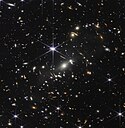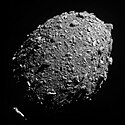2012 TV
| Discovery[1] | |
|---|---|
| Discovered by | Tenagra II Observatory |
| Discovery site | Nogales, Arizona |
| Discovery date | October 5, 2012 |
| Designations | |
| 2012 TV | |
| MPO 240124 | |
Apollo  NEO risk listed[2] | |
| Orbital characteristics[3] | |
| Epoch 2022-Jan-21 (JD 2459600.5) | |
| Uncertainty parameter 7 | |
| Observation arc | 1.8 days[2] |
| Aphelion | 2.361 AU (353.2 Gm) |
| Perihelion | 0.6439 AU (96.33 Gm) |
| 1.502 AU (224.7 Gm) | |
| Eccentricity | 0.5714 |
| 1.84 yr (672.7 d) | |
| 348° | |
| 0° 32m 6.72s /day[1] | |
| Inclination | 5.54° |
| 193.4° | |
| 2022-Feb-12.6 ± 1.5 days | |
| 270.0° | |
| Earth MOID | 0.002 AU (300,000 km)[3] |
| Mercury MOID | 0.34112 AU (51,031,000 km)[1] |
| Jupiter MOID | 2.83676 AU (424.373 Gm)[1] |
| Physical characteristics | |
| Dimensions | 24–54 meters |
| 0.0525 hr[3] | |
| 25.2[3] | |
2012 TV is a near-Earth Apollo asteroid with an estimated diameter of 30 metres (98 ft).[2] Its closest approach to the Earth was on October 7, 2012, with a distance of 0.0017 astronomical units (250,000 km; 160,000 mi).[3] It also approached the Moon an hour earlier with a distance of 0.0028 astronomical units (420,000 km; 260,000 mi).[3] With a short observation arc of 1.8 days, the asteroid is listed on the Sentry Risk Table and has a 1:500,000 chance of impacting Earth on April 2, 2081.[2]
As it will come to perihelion in mid-February 2022, it will be approaching Earth from the direction of the Sun. The closest approach possible during April 2022 is 0.66 LD (250,000 km), but it is expected to pass millions of kilometers from Earth.[3]
| Date | JPL SBDB nominal geocentric distance |
uncertainty region (3-sigma) |
|---|---|---|
| 2022-04-05.2 ± 4.3 days | 7.4 million km | ± 11.6 million km[4] |
See also
[edit]- List of asteroid close approaches to Earth in 2022
- List of asteroid close approaches to Earth in 2012
- 2012 TC4
- 2012 EG5
References
[edit]- ^ a b c d "2012 TV". Minor Planet Center. Retrieved 20 August 2017.
- ^ a b c d "Earth Impact Risk Summary: 2012 TV". NASA/JPL Near-Earth Object Program Office. Archived from the original on 26 October 2012. Retrieved 28 December 2021.
- ^ a b c d e f g h "(2012 TV)". JPL Small-Body Database. Jet Propulsion Laboratory. SPK-ID: 3609661. Retrieved 20 August 2017.
- ^ "Horizons Batch for 2022-Apr-05 03:53 UT". JPL Horizons. Archived from the original on 27 December 2021. Retrieved 27 December 2021.
External links
[edit]- 2012 TV at NeoDyS-2, Near Earth Objects—Dynamic Site
- 2012 TV at ESA–space situational awareness
- 2012 TV at the JPL Small-Body Database





